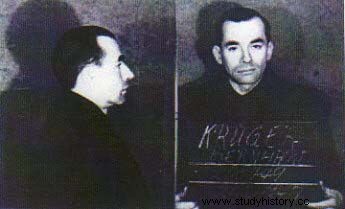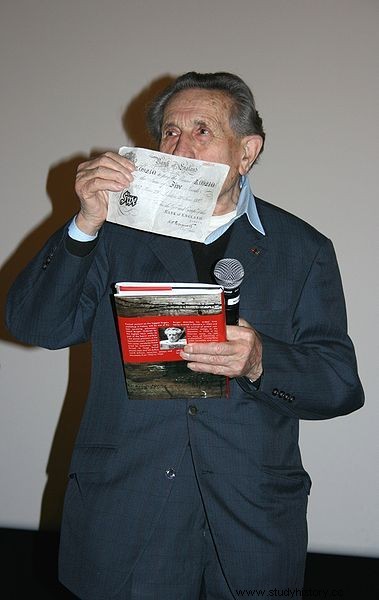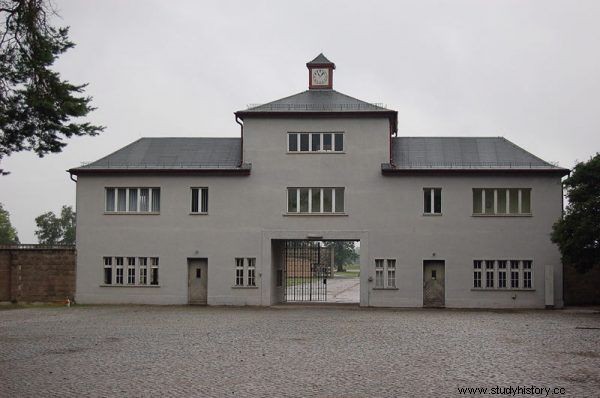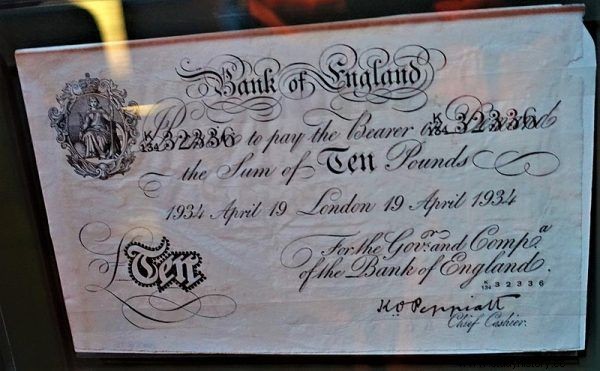It is believed that it was the greatest financial fraud in human history. It was supposed to weigh the scales of victory in World War II on the side of the Germans. Towards the end of the war, the Nazis began issuing perfectly counterfeit British pounds on a massive scale. Dozens of people worked on the counterfeit products. The left money was supposed to derail the British economy, and it almost happened. The Germans ran out of time. The rapid advances of the Red Army and the opening of a front in the West stopped the execution of Operation Bernhard.
From 1940, Germany tried to copy the British currency. The originator of the forgery was Alfred Naujocks, who had experience in hoaxes. He was in charge of the so-called the Gliwice provocation, which was used by the Germans as a pretext for a war with Poland.
Naujocks got the idea of counterfeiting pounds when he learned that the British used such methods too. Counterfeit food stamps were dropped over German cities to cause chaos and supply problems. The idea appealed to the deputy chief of the SS Reinhard Heydrich. The Führer himself also applauded him.
Unfortunately, copying the money issued by the Bank of England accurately proved to be an extremely difficult task. The Germans enlisted a certain Salomon Smolianoff, a Ukrainian Jew, a refugee from Soviet Russia, a forger and a criminal prosecuted in many European countries, but the results were poor.

Bernhard Krüger
The counterfeit pounds were easily recognizable and distinguishable from the originals. No wonder - the money issued by the Bank of England had a total of 150 different security features then there was the issue of the material from which they were made - its texture, color, thickness, etc.
After producing several million easily distinguishable copies, the Germans stopped working. Naujocks said goodbye to the project. He was replaced by Bernhard Krüger, an officer of the security service (SD), who previously worked, inter alia, in at the passport office of the German police. There he checked the credibility of the documents and there he was also impressed with the British passport. He was so impressed with the "quality of the workmanship" of the UK document that he even wrote to his boss about the need to use similar solutions in the outdated German passport.
The passport experience gave Krüger the passport to counterfeiting on a gigantic scale. The code name of the action was taken by the Germans from his name.
Manna from the British sky
The plan was simple. Bad money in denominations of 5, 10, 20 and 50 pounds could simply be dropped from German planes operating over the British Isles. Who wouldn't want to find a pack of money in their backyard? It was calculated that human greed would win and that the "lucky finders" would not admit this to the services, and would spend the money on their own ends.
Another way of putting left pounds into circulation was to "wash them out" in transactions around the world and thereby obtain the original currencies.
A flood of the British economy with a flimsy currency would destroy confidence in the pound , would drastically weaken its position around the world, would disrupt supply chains, and a flood of money could result in inflation and other economic perturbations.
Devil's workshop
So the game was worth the candle. Joseph Goebbels called it a "grotesque plan." Great Albion would have died thanks to a cheeky mammon.
The Germans realized, however, that there was no question of any quick effects. Krüger decided to approach the matter more methodically. Out of thousands of concentration camp prisoners (mainly Sachsenhausen and Oświęcim), he finally selected 142 people to deal with the perfect forgery. The team consisted of printers, graphic designers, painters, draftsmen, bookbinders, engravers, photographers, typesetters, electroplating artists, bankers, securities specialists, hairdressers (due to their manual dexterity) and representatives of many other specialties. They had a better fate for a while than vegetation and hunger, or a gas chamber. They shed their camp uniforms in favor of white research coats, received normal food rations and worked 8 hours each. But they also knew that regardless of the success of the action, they were to be killed.

Adolf Burger was one of the inmates forced to produce counterfeit pounds. It was he who called the prisoners "dead bodies on vacation", because everyone was aware that regardless of the outcome of the operation, they would die
The team of forgers was divided into two isolated and masked barracks - no. 18 and 19 in the Sachsenhausen camp. Years later, Adolf Burger, one of the prisoners and participants of the forgery, thanks to which the world learned about Operation Bernhard, called the barracks "the devil's workshop."
"We were dead on vacation," Burger recalled.
Everything that happened inside was top secret. Even the guards did not know about the purpose of the barracks. The Germans organized photo laboratories and engraving stations there, and they downloaded the most modern Victoria printing machine - Tiegel 4.
Ragged pounds
The Nazis intended to produce 4.5 billion pounds. However, the task turned out to be extremely difficult.
One of the biggest problems was the material from which the pounds were made. The Germans were sure that it was linen, but still they could not get the same material parameters - color, strength, etc.
It took the counterfeiting team a year to figure out the "paper" used to make the pounds. They even pulled flax from Turkey, and so did the Bank of England. All in vain. The material still didn't behave the same way, didn't rustle properly like real pounds.
In the end, by trial and error, it turned out that the islanders use inferior quality linen and wash it before production. The Germans repeated this process. The linen was cut into rags, it was deliberately soiled, then washed and dried. The effect turned out to be perfect.

The production of false pounds involved, among others, prisoners from Sachsenhausen
In fact, the British did not wash rags, but used old linen mail bags for the production of pounds, which were ground and processed according to a recipe dating back to the 18th century. However, Hitler's washed rags turned out to have the same effect.
It was also extremely difficult to counterfeit watermarks, the lines of which were alternately dark and light. Ultimately, a total of 148 out of 150 specific security features of the banknote were counterfeited, but that was not the end, because it had to be assigned the appropriate number as well. Outstanding mathematicians were hired to crack the algorithm used to encrypt the date, banker's signature, and serial number, although apparently the Germans eventually obtained this knowledge from a traitor from the islands, a Bank of England official. The only thing the counterfeiters had no problem with was ink to make money. It turned out that it was bought by the Bank of England from one of the ... German producers.
The first perfectly counterfeit pounds came from the camp "printing house" in Sachsenhausen in early 1943. By the end of the year, counterfeiters were already printing one million counterfeit notes a month. Those that met the highest standards for resemblance to the original were deliberately dirty and mint to make them look old. Since the English usually carried money fastened with a special buckle, not in the wallet but directly in the pockets of their trousers, a special group of prisoners was supposed to make the banknotes look like they were fastened with clasps many times.
It is estimated that by the end of the war, Germany had produced nearly 9 million pounds worth of about 135 million pounds.
Worse money drives better
The original plan to drop a large amount of cash from planes over Britain ultimately failed due to a machinery problem. There was, however, another way to circulate pounds around the world. The Nazis bought goods and raw materials for them in Italy, paid in colonial or neutral countries, and paid local agents. Even one of the most famous spies of World War II - a certain Cicero (Elias Bazna), who spied for the Germans at the British embassy in Turkey, was paid for his services in left pounds. After the war, Cicero demanded that Germany settle its bills in real money.
Gradually, from 1944, the pounds began to penetrate into Great Britain.

Counterfeit ten pound note
The effect was what the Germans expected. The British monetary system began to break down. The pound is no longer a reliable means of payment. In a short time it was devalued by 75%. Foreign banks refused to accept the currency.
The Bank of England had to save itself by withdrawing all its higher denomination money from circulation to verify its origin. Only five pounds left in circulation.
In total, bad money worth nearly 1/3 of British gold reserves was in circulation. Ultimately, however, the plan did not bring the expected results. Due to the turmoil of war, the counterfeiting slowed down, the Germans had more and more problems with bringing linen from Turkey for the production of pounds. At the end of 1944, they tried to switch to counterfeiting dollars.
Money in the lake
Ultimately, nothing came of it. Just before the end of the war, the guards hurriedly dismantled the camp's printing house. In early May 1945, several dozen sealed, waterproof crates with printing presses, and 73 million of counterfeit pounds sterling disappeared into the depths of the Austrian lake Toplitz. They were excavated from there in 1959.
And the camp forgers? "Dead bodies on vacation" as one of the team members aptly called them - they were lucky. Just before the capitulation, they were transferred from camp to camp. Eventually they ended up in the Ebensee camp in upper Austria. They reckoned it was their last days.

Much of the counterfeit money was found in Lake Toplitz
On May 5, 1945, however, the camp day began differently than usual. There were no guards, officers, Germans…. They fled from the coming Americans. Almost all (apart from a few prisoners executed by Krüger's order during the war) survived. Just like the brain of the operation - that is, Bernard Krüger. Despite the fact that after the war he was tried for the deaths of several prisoners suffering from tuberculosis, shot after he ordered them to be thrown out of the barracks, he was not convicted in the end. He lived to see an old age. He died in 1989.
